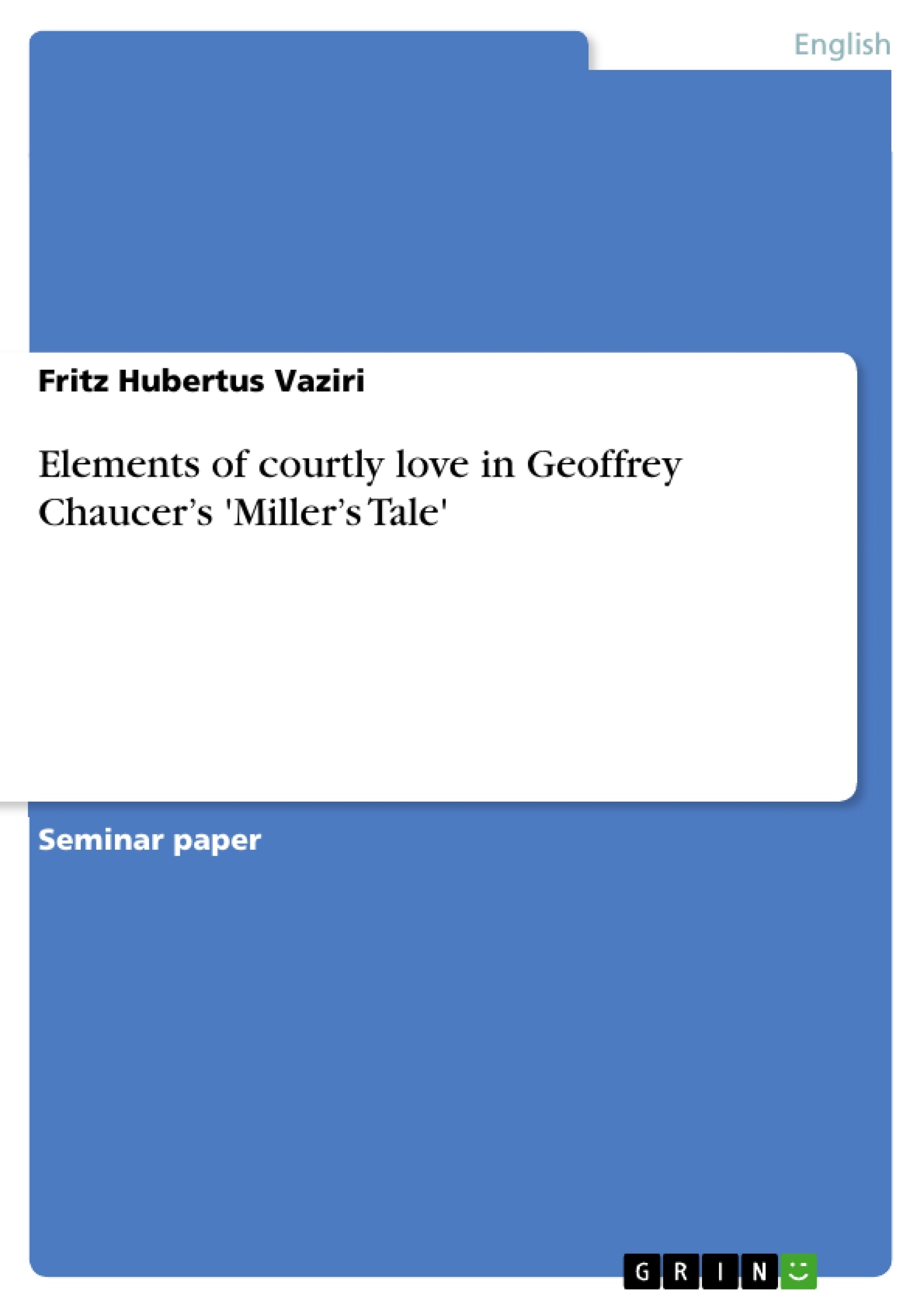When approaching an investigation on the elements of courtly love in a piece of literature as for instance Geoffrey Chaucer’s Miller’s Tale, it seems more than reasonable to first of all clarify what the term actually means, i.e. what the focus of study is to be. Consequently, such a clarification constitutes the beginning and also the basis of the examination developed in the course of this paper. It might not be a clarification, however, but at least to a certain extent rather an illustration of the scholarly controversy connected with amour courtois and its English equivalent. Still, ample characteristics of the concept behind the term will be found which are suited to be analyzed in the light of their application in the Miller’s Tale. A preceding brief observation of Chaucer’s Knight’s Tale in the context of this issue is inserted for the purpose of gaining a more differentiated view onto the appearance of elements of courtly love in the second of the Canterbury Tales. A final conclusion will sum up central findings. Since its introduction in the nineteenth century a lot of controversy has surrounded the term amour courtois, as far as its use and necessity are concerned. What are the reasons for such difficulties in finding consent here and what are the various connotations involved in the idea of courtly love? It is by no means possible to thoroughly illustrate all conflicting positions in detail on the following pages, but some significant arguments will be outlined hereafter. A brief look at the development of the notion of courtly love might be helpful in reaching a better understanding of the issue at hand. Where does the term actually come from? When was it developed and by whom? BOASE states that the “term amour courtois was coined by Gaston Paris […] in 1883.” He adds that it is disputed amongst scholars, whether the idea of courtly love is an invention of the Middle Ages.” LEWIS believes that courtly love appeared “quite suddenly at the end of the eleventh century in Languedoc”. He continues that it was introduced by Provençal Troubadours and served as an influential factor in European literature up to the nineteenth century.
Inhaltsverzeichnis (Table of Contents)
- Introduction.
- Courtly love.
- Some theories on the origin of courtly love.
- Characteristics of courtly love.
- Courtly love in the Knight's Tale.
- The Miller's Tale
- Genre
- Elements of courtly love.
- Alison
- Absolon
- Nicholas
- Conclusion.
Zielsetzung und Themenschwerpunkte (Objectives and Key Themes)
This paper examines the elements of courtly love in Geoffrey Chaucer's Miller's Tale. It first defines the term "courtly love" and explores its various interpretations and origins, drawing upon scholarship from Gaston Paris, C.S. Lewis, and Roger Boase. The paper then investigates the characteristics of courtly love, including humility, courtesy, adultery, and the "religion of love," drawing upon the work of scholars such as Douglas Gray, F.X. Newman, and R.H. Green. Finally, the paper analyzes the Miller's Tale with a particular focus on the characters of Alison, Absolon, and Nicholas, to explore how their relationships and actions reflect or subvert the conventions of courtly love.- The definition and historical context of courtly love.
- The characteristics of courtly love and its relationship to feudalism and Christianity.
- The portrayal of courtly love in Chaucer's Knight's Tale as a point of reference.
- The presence and subversion of courtly love elements in the Miller's Tale.
- The relationship between courtly love and gender roles in the text.
Zusammenfassung der Kapitel (Chapter Summaries)
The paper begins by introducing the topic of courtly love and the scholarly controversy surrounding its meaning and origins. It highlights the influence of Provençal Troubadours and the work of scholars such as Gaston Paris and C.S. Lewis. The paper then explores the characteristics of courtly love, emphasizing its emphasis on humility, courtesy, adultery, and the "religion of love." It also discusses the contrasting perspectives on courtly love, particularly those that view it as a form of "idolatrous passion." The paper further examines the portrayal of courtly love in Chaucer's Knight's Tale before moving on to analyze the Miller's Tale and the presence or absence of courtly love elements in the characters of Alison, Absolon, and Nicholas.Schlüsselwörter (Keywords)
The paper primarily focuses on the concepts of courtly love, chivalry, adultery, medieval literature, Chaucer, and the Canterbury Tales. It explores the themes of love, gender, social hierarchy, and the relationship between literature and society in the Middle Ages.- Quote paper
- Fritz Hubertus Vaziri (Author), 2007, Elements of courtly love in Geoffrey Chaucer’s 'Miller’s Tale', Munich, GRIN Verlag, https://www.grin.com/document/113294




